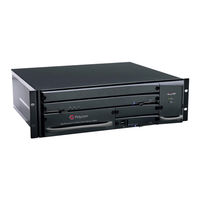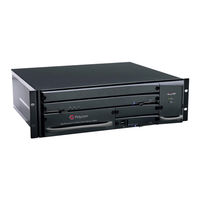Polycom RealPresence 2000 Manuals
Manuals and User Guides for Polycom RealPresence 2000. We have 5 Polycom RealPresence 2000 manuals available for free PDF download: Administrator's Manual, Administration Manual, Getting Started Manual
Polycom RealPresence 2000 Administrator's Manual (1138 pages)
Collaboration Server
Table of Contents
-
-
-
-
-
Gathering Phase106
-
Overlay Layouts109
-
-
-
Flag Settings167
-
W448P Resolution169
-
-
-
Content Settings179
-
-
-
System Level209
-
-
Conference Level209
-
-
-
-
Packet Loss235
-
-
-
-
Basic Cascading268
-
-
-
Meeting Rooms
308 -
Entry Queues
314-
Entry Queue322
-
-
Address Book331
-
-
-
-
-
Day View360
-
Week View360
-
List View361
-
Today View361
-
-
-
Requesting Help388
-
Audible Alarms390
-
-
-
-
-
Machine Account483
-
Listing Users483
-
Deleting a User485
-
Disabling a User486
-
Enabling a User486
-
Renaming a User487
-
Active Directory489
-
Using Notes490
-
-
-
Lan Redundancy529
-
Media Redundancy529
-
-
Network Security
549-
-
Gateway Profiles569
-
Hardware Monitor570
-
Ivr Services579
-
Adding Languages582
-
-
Direct Dialing638
-
Ip Participants638
-
-
-
-
-
-
-
Mcus Pane676
-
Conferences Pane678
-
List Pane679
-
Status Bar679
-
-
-
-
-
System Alerts703
-
-
Rmx Time706
-
-
Resource Reports715
-
Port Gauge718
-
-
Mib Files729
-
Private Mibs729
-
-
Hot Backup743
-
Banner Display756
-
-
Using Ping760
-
-
Activex Bypass778
-
-
Deleting a Flag825
-
-
Renaming Users854
-
Password Length856
-
Session Timeout859
-
-
Fan Properties901
-
Cards Monitor943
-
Mcu Monitor943
-
Error Buffer944
-
-
-
-
Database Application1015
-
Ad Hoc Settings1019
-
-
-
Restoring Defaults1030
-
-
-
Cisco Tip Support1050
-
Look and Feel1053
-
-
Realconnect for Lync1059
-
-
Cisco Equipment1080
-
Polycom Equipment1080
-
Configuring Cma1081
-
Configuring Dma1081
-
Cts1091
-
Hdx / Itp1091
-
Sender1091
-
-
Prefer TIP1092
-
-
-
Cts1092
-
Hdx* / Itp1092
-
Sender1092
-
Video & Content1092
-
Advertisement
Polycom RealPresence 2000 Administrator's Manual (1130 pages)
Brand: Polycom
|
Category: Network Hardware
|
Size: 35 MB
Table of Contents
-
-
-
-
-
Flag Settings144
-
-
H.239 Protocol148
-
-
Content Settings154
-
Gathering Phase180
-
Auto Scan183
-
Media Encryption186
-
-
-
Guidelines226
-
Stereo227
-
-
Guidelines238
-
Basic Cascading240
-
Guidelines243
-
-
-
-
Meeting Rooms
279 -
-
SIP Factories298
-
-
Address Book303
-
-
Address Book
304 -
Reservations
329-
Reservations330
-
-
Day View333
-
-
-
Audible Alarms360
-
-
-
-
Toolbar Buttons365
-
-
Polycom RealPresence 2000 Administrator's Manual (1113 pages)
collaboration server rmx
Brand: Polycom
|
Category: Conference System
|
Size: 22 MB
Table of Contents
-
Overview32
-
Polycom, Inc38
-
-
Polycom, Inc42
-
-
-
Polycom, Inc57
-
Polycom, Inc60
-
-
-
-
Flag Settings151
-
W448P Resolution152
-
-
Content Settings162
-
-
-
-
Video Preview217
-
-
-
Closed Captions254
-
-
-
Meeting Rooms
299 -
-
-
SIP Factories317
-
Address Book
323 -
-
-
-
Today View351
-
-
-
-
Advertisement
polycom RealPresence 2000 Administration Manual (449 pages)
Collaboration Server
Table of Contents
-
-
-
-
Add an MCU37
-
-
-
Polycom RealPresence 2000 Getting Started Manual (70 pages)
Collaboration Server Virtual Edition
Table of Contents
Advertisement
Related Products
- Polycom RealPresence RMX 1500
- Polycom RealPresence RMX 2000
- Polycom RealPresence Collaboration Server Virtual Edition 1800
- Polycom RealPresence Collaboration Server Virtual Edition 2000
- Polycom RealPresence Collaboration Server Virtual Edition 4000
- Polycom ReadiManagerLX100
- Polycom Collaboration Server (RMX) 1500
- Polycom Collaboration Server (RMX) 1800
- Polycom RSS 4000
- Polycom RAS 200I




